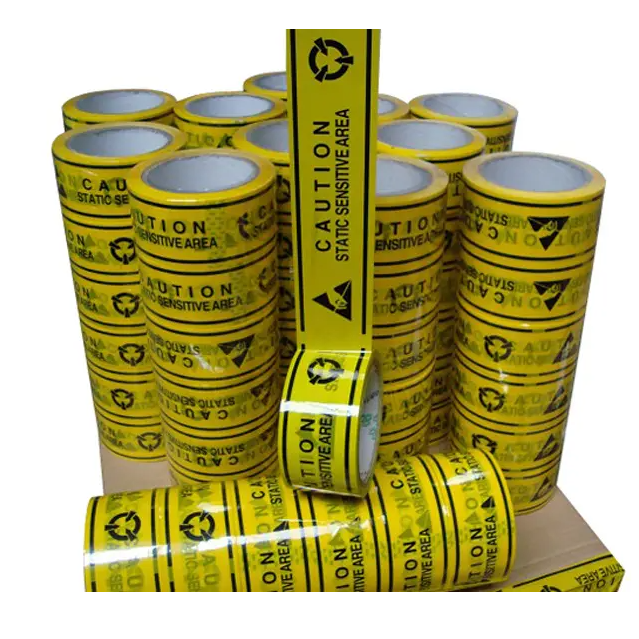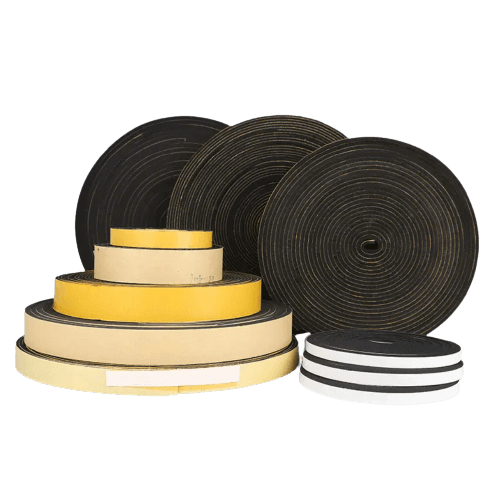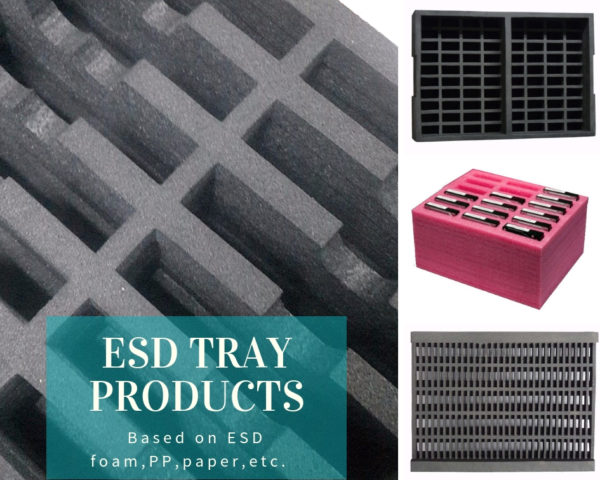ESD Tape: The Unsung Hero in Electronics Manufacturing
In the fast-paced world of electronics manufacturing, every detail matters. And yet, there's one crucial component that often goes unnoticed – ESD tape.
ESD, or Electrostatic Discharge, can wreak havoc on delicate electronic devices, causing irreparable damage and costly production delays. ESD tape acts as a protective shield, dissipating static electricity and preventing it from harming sensitive components. From preventing electrical shorts to safeguarding against static discharges during handling and transportation, ESD tapes are the unsung hero that ensures the smooth operation of electronic assemblies.
With advances in technology and the increasing complexity of electronic devices, the demand for ESD tapes has never been greater. Manufacturers are turning to high-quality ESD tapes that meet stringent industry standards to safeguard their delicate components and protect their brand reputation.
In this article, we will delve into the world of ESD tape, exploring its importance in electronics manufacturing and the key factors to consider when choosing the right tape for your applications. Join us as we uncover the unsung hero of the electronics industry – ESD tape.
The importance of ESD protection in electronics manufacturing
Electrostatic Discharge (ESD) is a phenomenon that occurs when two objects with different electrical potentials come into contact or are separated. This discharge can cause damage to sensitive electronic components, leading to malfunctions or complete failure of the device. In the highly sensitive environment of electronics manufacturing, where even the tiniest defect can have catastrophic consequences, ESD protection is of utmost importance.
ESD tape creates a controlled path for the discharge to flow safely, reducing the risk of damage to the electronic assembly. By implementing ESD protection measures, manufacturers can ensure the quality and reliability of their products, minimizing the risk of costly returns, warranty claims, or even safety hazards.
ESD tape is not only crucial during the manufacturing process but also throughout the entire lifecycle of the electronic product. From preventing electrical shorts to safeguarding against static discharges during handling and transportation, ESD tape is the unsung hero that ensures the smooth operation of electronic assemblies.
How ESD tape works to prevent electrostatic discharge
ESD tape is made from a specialized material that has a high resistance to electrical charge. It is designed to conduct electricity along its surface, allowing any static charge to safely dissipate. The tape is usually applied to surfaces where the risk of ESD is high, such as workbenches, assembly lines, and storage containers.
When a static discharge occurs, the ESD tape provides a low-resistance pathway for the charge to flow through, effectively grounding it. This prevents the charge from accumulating and reaching the sensitive electronic components. The tape acts as a barrier, protecting the assembly from potentially damaging voltage spikes and ensuring the integrity of the electronic circuitry.
Different types of ESD tape and their applications
ESD (Electrostatic Discharge) tape comes in various types, each designed to address specific needs in the electronics manufacturing and handling process. Here are some common types of ESD tape:
ESD Marking Tape:
Characteristics: This type of tape is often used for marking ESD-safe zones and designated areas in manufacturing facilities.
Color Coding: ESD marking tapes may come in different colors, helping to visually distinguish between various workstations or zones with different ESD sensitivity levels.

ESD Floor Tape:
Application: Designed for use on floors, ESD floor tape helps create ESD-safe pathways and demarcate safe areas within a facility. ESD marking tape may also be used instead.
Adhesive Strength: Typically features strong adhesive properties to ensure it adheres securely to the floor.

ESD Grid Tape:
Grid Pattern: ESD grid tape is made of anti-static OPP material. It often has a gridded pattern, It has the characteristic of discharging static charge and has transparency. When used, it only produces static voltage below 100V (general tape ≥ 5000V), which greatly reduces the static hazards produced by product packaging. It is suitable for the packaging of electronic products and the marking of anti-static clothing.
Common Use: Widely used during the assembly and manufacturing of electronic components to secure and ground items effectively.
ESD Grid Tapes Specifications:
Resistance value of adhesive surface 10^8Ω-10^10Ω.
Tape Colors: Black, Yellow, Silver.
Width: 6mm, 8mm, 10mm, 12mm, 15mm, 20mm, 23mm, 25mm, 28mm, 30mm, 32mm, 35mm, 40mm, 42mm, 45mm, 50mm, 60mm, 70mm, 80mm, 100mm
Length: 36m
Product characteristics: anti-static, no residual adhesive, strong adhesion

ESD Caution Tape:
Safety Signaling: Caution tapes with ESD properties are used to warn individuals about the presence of ESD-sensitive areas or materials.
Visibility: Usually incorporates ESD symbols and warnings for clear identification.

ESD Shielding Tape:
Material: Made from conductive materials to provide a shielding effect against electrostatic discharge.
Applications: Commonly used for sealing ESD shielding bags or wrapping ESD-sensitive components for added protection.

ESD Kapton Tape:
Material: Kapton is a polyimide film known for its excellent thermal and electrical insulation properties.
Applications: ESD Kapton tape is used in applications where high-temperature resistance and ESD protection are essential, such as in the aerospace and electronics industries.

ESD Clear Tape:
Transparent: is made of OPP film coated with pressure-sensitive adhesive with antistatic agent after antistatic treatment, the whole roll is light yellow, but it is completely transparent after pulling it apart, allowing for visibility of components or labels underneath. The resistance value of the adhesive surface is 10^8Ω-10^10Ω.
Common Use: Applied in situations where clarity is important, such as fixing labels or tags on electronic components, circuit board overpacks, laptops, cell phones, and other products requiring antistatic protection, as well as for use in clean rooms.
Product specifications: tape width from 5mm to 60mm, length 36m, width can be customized


ESD Conductive Grid Tape:
Conductive Properties: Features a conductive grid pattern to ensure proper grounding and dissipation of static charges.
Applications: Ideal for applications where a high level of conductivity is required, such as in the assembly of sensitive electronic devices.
Product specifications: tape width from 5mm to 60mm, length 36m, width can be customized

ESD Foam Tape : if you are interested in ESD Foam Tape, please refer to previous article.

Selecting the appropriate type of ESD tape depends on the specific requirements of the application, including the nature of the materials being handled, the environmental conditions, and the desired level of ESD protection. It's crucial to choose the right ESD tape to maintain the integrity and reliability of electronic components throughout the manufacturing and handling processes. Each type of ESD tape has its own set of advantages and applications. Manufacturers should carefully assess their specific needs and requirements to choose the most suitable type of tape for their applications.
Benefits of using ESD tapes in electronics manufacturing
To maximize the effectiveness of ESD tape in electronics manufacturing, it is essential to follow best practices. Here are some key considerations:
Using ESD (Electrostatic Discharge) tape in electronics manufacturing provides several crucial benefits to safeguard sensitive components and ensure the overall quality and reliability of electronic products. Here are some key advantages:
- Prevention of Electrostatic Discharge (ESD) Damage:
- Primary Purpose: ESD tape serves as a protective barrier, preventing the build-up and discharge of static electricity that could potentially damage sensitive electronic components.
- Benefit: By dissipating static charges and grounding materials, ESD tape significantly reduces the risk of ESD-related damage during manufacturing, assembly, and transportation.
- Enhanced Component Reliability:
- Reduced Defects: The use of ESD tape contributes to a reduction in defects and malfunctions caused by electrostatic discharge, leading to increased reliability of electronic components and finished products.
- Consistent Performance: Protecting components from ESD ensures they maintain their intended functionality over time.
- Compliance with Industry Standards:
- Regulatory Requirements: Electronics manufacturers often need to comply with industry standards and regulations regarding ESD control to ensure product quality.
- Benefit: Incorporating ESD tape into manufacturing processes helps meet these compliance requirements, demonstrating a commitment to quality and safety standards.
- ESD-Safe Work Environments:
- Controlled Areas: ESD tape is used to designate and create ESD-safe zones within manufacturing facilities.
- Benefit: Establishing controlled work environments ensures that personnel are aware of the presence of ESD-sensitive materials and are more likely to follow proper ESD-safe practices.
- Protection During Transportation and Storage:
- Packaging Integrity: ESD tape is often used to seal ESD shielding bags and secure packaging for electronic components.
- Benefit: Ensuring the integrity of ESD-sensitive materials during transportation and storage minimizes the risk of damage caused by external factors.
- Identification of ESD-Sensitive Areas:
- Marking and Signaling: ESD tape can be used for marking and signaling ESD-sensitive areas and equipment.
- Benefit: Clearly identifying such areas helps prevent accidental mishandling of components, reducing the likelihood of ESD incidents.
- Versatility in Applications:
- Various Types: ESD tapes come in different types, including floor tapes, marking tapes, shielding tapes, and more.
- Benefit: The versatility of ESD tape allows it to be applied in various applications, addressing specific needs in different stages of electronics manufacturing.
- Cost-Effective ESD Protection:
- Preventive Measure: Investing in ESD tape is a cost-effective preventive measure compared to the potential costs associated with damaged components and product recalls.
- Benefit: The relatively low cost of ESD tape makes it an efficient and essential component of an overall ESD control strategy.
The use of ESD tape in electronics manufacturing is integral to maintaining the integrity of sensitive components, ensuring product reliability, and meeting industry standards for quality and safety. It serves as a proactive measure to prevent ESD-related damage and contributes to the overall success and longevity of electronic products.
Best practices for using ESD tapes in manufacturing processes
Despite its importance, ESD tape is often misunderstood or overlooked in the electronics manufacturing industry. Let's address some common misconceptions:
- ESD tapes are unnecessary in controlled environments: While it is true that controlled environments, such as cleanrooms, have measures in place to minimize ESD risks, ESD tape still plays a crucial role. It provides an additional layer of protection and helps to mitigate any potential ESD incidents that may occur due to human error or equipment malfunction.
- Any tape can provide ESD protection: Not all tapes are created equal when it comes to ESD protection. Regular adhesive tapes may not have the necessary conductivity or grounding capabilities to effectively dissipate static charges. It is essential to use specialized ESD tape that meets the required industry standards to ensure reliable ESD protection.
- ESD tapes are only necessary during manufacturing: ESD protection should be implemented throughout the entire lifecycle of the electronic product. From assembly to packaging and transportation, ESD tape helps to safeguard the product from ESD damage at every stage.
Common misconceptions about ESD tape
While ESD tape plays a crucial role in protecting electronic components from electrostatic discharge, there are several misconceptions associated with its use. Here are some common misconceptions:
-
ESD Tape Eliminates All Risks of Electrostatic Discharge:
- Misconception: Some may believe that using ESD tapes alone guarantees complete protection against electrostatic discharge.
- Reality: While ESD tapes are an essential component of ESD protection, it is just one element of a comprehensive ESD control program. Proper grounding, personnel training, and adherence to ESD-safe practices are also critical.
-
All ESD Tapes Are the Same:
- Misconception: Assuming that all ESD tapes offer the same level of protection and features.
- Reality: ESD tapes come in various types, each designed for specific applications. Some tapes may have conductive properties, while others may serve as marking or floor tapes. Choosing the right type depends on the intended use and the specific requirements of the environment.
-
ESD Tapes are Only Necessary for Electronic Components:
- Misconception: Believing that ESD tape is only required for securing and protecting electronic components.
- Reality: ESD-sensitive areas extend beyond electronic components. Workstations, floors, and even packaging materials may require ESD tape to maintain a static-free environment throughout the manufacturing and handling processes.
-
ESD Tapes are Only Relevant in Manufacturing Facilities:
- Misconception: Assuming that ESD tape is only necessary in large-scale manufacturing environments.
- Reality: ESD protection is relevant in various settings, including laboratories, repair facilities, and small-scale electronics assembly areas. Any location where ESD-sensitive components are handled can benefit from ESD control measures.
-
ESD Tapes are Permanent and Never Needs Replacement:
- Misconception: Believing that once ESD tape is applied, it provides permanent protection without the need for replacement.
- Reality: ESD tape may wear out over time, especially in high-traffic areas or under harsh manufacturing conditions. Regular inspections and replacement are essential to ensure continued effectiveness.
-
ESD Tape Does Not Affect Productivity:
- Misconception: Assuming that implementing ESD control measures, including the use of ESD tape, slows down production processes.
- Reality: Proper ESD control measures can be seamlessly integrated into workflows, and the potential costs associated with ESD damage far outweigh any minor adjustments made to accommodate protective measures.
-
ESD Tape Is Only About Compliance, Not Performance:
- Misconception: Believing that ESD control measures, including ESD tape, are primarily implemented for regulatory compliance rather than enhancing product performance.
- Reality: While compliance is essential, the primary goal of ESD control measures is to maintain the reliability and performance of electronic components, reducing the risk of failures and defects.
It's important for individuals working in electronics manufacturing or handling sensitive components to be aware of these misconceptions and ensure that their understanding of ESD tape aligns with the realities of effective electrostatic discharge protection.
Case studies showcasing the effectiveness of ESD tapes
Choosing the right ESD tapes for your specific manufacturing needs is crucial to ensure optimal ESD protection. Here are some factors to consider:
- Conductivity: Depending on the level of ESD protection required, manufacturers should choose ESD tape with the appropriate level of electrical conductivity. Conductive ESD tape offers the highest level of conductivity, while anti-static tape provides a lower level of conductivity.
- Compatibility: It is important to ensure that the ESD tape is compatible with the materials and surfaces it will come into contact with. Some materials or coatings may be sensitive to certain types of ESD tape, which could lead to compatibility issues or damage to the electronic assembly.
- Adhesion and durability: ESD tape should have strong adhesion properties to ensure it stays securely bonded to the surface. It should also be durable enough to withstand the rigors of the manufacturing process, including handling, transportation, and exposure to various environmental conditions.
- Industry standards: Check if the ESD tape meets the necessary industry standards for ESD protection. Look for certifications or compliance labels that indicate the tape's performance and suitability for specific applications.
How to choose the right ESD tapes for your manufacturing needs
ESD tapes may often go unnoticed, but its importance in electronics manufacturing cannot be overstated. It serves as a protective shield against electrostatic discharge, ensuring the reliability and longevity of electronic products. By dissipating static electricity and preventing it from damaging sensitive components, ESD tapes play a crucial role in maintaining product quality and minimizing the risk of costly failures.
As the electronics industry continues to advance and devices become increasingly complex, the demand for ESD tape will continue to grow. Manufacturers must prioritize ESD protection and choose high-quality ESD tape that meets industry standards to safeguard their delicate components and protect their brand reputation. By recognizing the unsung hero of the electronics industry – ESD tape – manufacturers can ensure the smooth operation of electronic assemblies and deliver reliable products to their customers.
Contact ESDGoods For ESD Tape Wholesale
If you are looking to purchase ESD (Electrostatic Discharge) tape in bulk or wholesale quantities, there are several options available to you. contact us directly to inquire about wholesale options and pricing.



